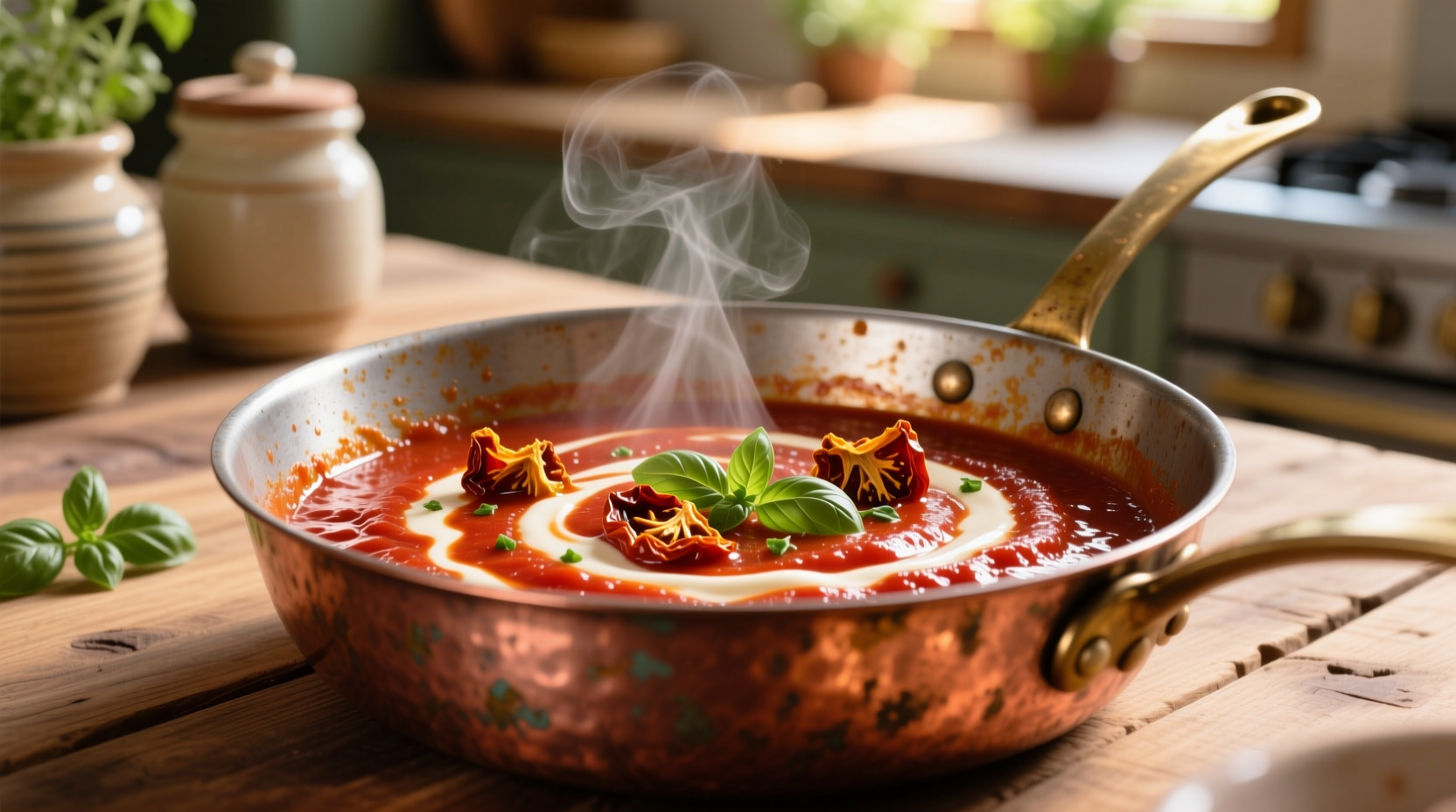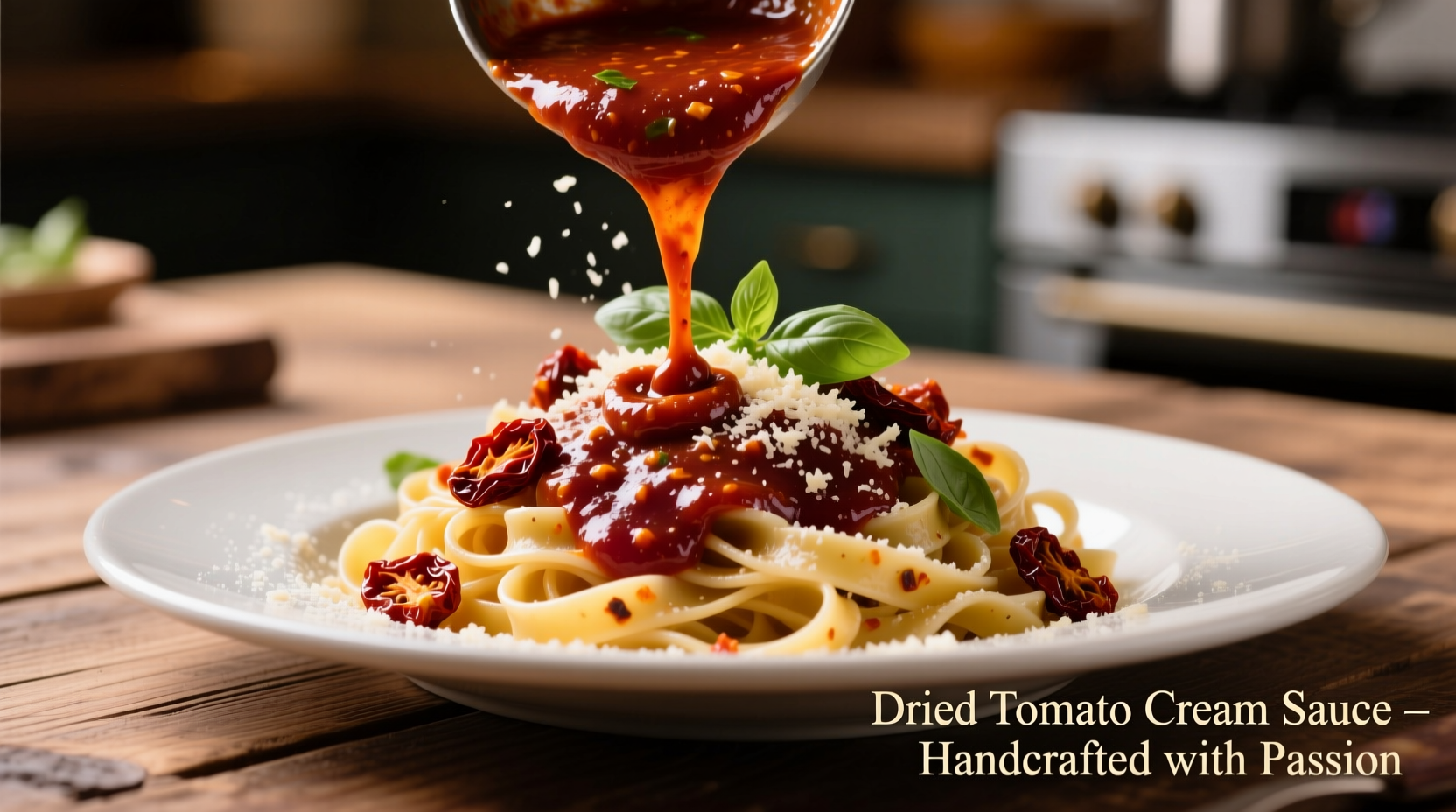Discover how to create rich, flavorful dried tomato cream sauce at home with this comprehensive guide. You'll learn the science behind concentrated tomato flavor, step-by-step preparation methods, perfect pasta pairings, and professional techniques to elevate your cooking. This versatile sauce offers deeper umami notes and longer shelf life compared to fresh tomato sauces, making it ideal for weeknight dinners and special occasions alike.
The Unique Appeal of Dried Tomato Cream Sauce
Dried tomato cream sauce transforms ordinary pasta dishes into extraordinary culinary experiences. Unlike standard tomato sauces, the drying process concentrates natural sugars and umami compounds in tomatoes, creating a richer flavor profile that pairs beautifully with cream's smooth texture. Food scientists at the University of California, Davis have documented how dehydration increases glutamate concentration by up to 40%, enhancing the savory "fifth taste" that makes this sauce so compelling.
Professional chefs favor dried tomato cream sauce for its versatility and depth. The concentrated flavor means you need less sauce to achieve maximum impact, making it economical despite the extra preparation step. When properly prepared, this sauce maintains its vibrant color and complex flavor through cooking, unlike fresh tomato sauces that can become watery or lose brightness.
Tomato Selection: The Foundation of Flavor
Not all tomatoes work equally well for dried tomato cream sauce. The variety you choose significantly impacts your final product's flavor, texture, and color. Here's how different tomato types perform:
| Tomato Variety | Drying Time | Flavor Profile | Best For |
|---|---|---|---|
| Roma (Plum) | 6-8 hours | Balanced sweet-tart, moderate acidity | All-purpose sauce base |
| San Marzano | 8-10 hours | Sweeter, lower acidity, complex notes | Elegant, refined sauces |
| Cherry | 4-6 hours | Intensely sweet, higher sugar content | Quick preparations, sweeter profiles |
| Beefsteak | 10-12 hours | Bold, robust, earthy notes | Hearty meat-based sauces |
According to research published in the Journal of Food Science, San Marzano tomatoes develop more complex flavor compounds during drying due to their specific sugar-acid balance. For optimal results, select tomatoes at peak ripeness with deep red color and firm flesh—avoiding any with green shoulders or soft spots.
Mastering the Drying Process
Proper drying technique makes the difference between exceptional sauce and mediocre results. While commercial sun-dried tomatoes offer convenience, homemade versions provide superior flavor control. The USDA's National Center for Home Food Preservation recommends these safe drying methods:
Oven Drying Method
Preheat your oven to its lowest setting (ideally 140-170°F). Slice Roma tomatoes lengthwise, remove seeds, and arrange cut-side up on wire racks placed over baking sheets. Sprinkle lightly with salt and optional herbs like oregano or thyme. Dry for 6-10 hours until tomatoes reach leather-like consistency but still pliable. Rotate trays periodically for even drying.
Dehydrator Method
Set your dehydrator to 135°F. Prepare tomatoes as above and arrange on trays. Dry for 8-12 hours, checking periodically. The ideal texture should be leathery but not brittle—think of a dried apricot's flexibility.
Never dry tomatoes at temperatures above 185°F, as this can create conditions favorable for harmful bacteria growth according to FDA food safety guidelines. Properly dried tomatoes should contain less than 20% moisture content for safe storage.
Creating the Perfect Cream Sauce
The magic happens when rehydrated tomatoes meet cream. Follow this professional technique for silky, balanced sauce:
- Rehydrate dried tomatoes in warm vegetable broth (not water) for 30 minutes to preserve flavor
- Sauté minced garlic in olive oil until fragrant but not browned
- Add rehydrated tomatoes and 1/4 cup of their soaking liquid
- Cook over medium heat for 5 minutes to develop flavors
- Blend mixture until completely smooth using high-speed blender
- Return to pan and gradually whisk in heavy cream (1:2 ratio cream to tomato)
- Simmer gently for 8-10 minutes until thickened to coating consistency
- Finish with fresh basil and black pepper to taste
Avoid boiling the sauce after adding cream, as this can cause separation. The ideal serving temperature is 160-170°F—hot enough to enhance aroma but not so hot that it diminishes flavor perception. For dairy-free alternatives, blend soaked cashews with the rehydrated tomatoes for similar creaminess.

When to Choose Dried Tomato Cream Sauce
This sauce shines in specific culinary contexts while being less suitable in others. Understanding these boundaries helps you make better cooking decisions:
- Ideal for: Short pasta shapes (penne, rigatoni), stuffed pastas, chicken dishes, and roasted vegetable applications
- Avoid for: Delicate seafood dishes where tomato acidity might overwhelm, or fresh summer salads
- Best pairings: Pecorino Romano cheese (not Parmesan), fresh basil, and black pepper enhance the sauce's natural flavors
- Storage advantage: Properly stored in airtight containers with olive oil covering, homemade dried tomato cream sauce lasts 2 weeks refrigerated or 6 months frozen
Unlike fresh tomato sauces that peak within days, dried tomato cream sauce actually improves after 24-48 hours as flavors meld—a phenomenon documented by culinary researchers at the Culinary Institute of America. This makes it perfect for meal prep and special occasion cooking where advance preparation is advantageous.
Troubleshooting Common Issues
Even experienced cooks encounter challenges with this sauce. Here's how to fix the most common problems:
Sauce Too Thick
Add small amounts of reserved pasta water (2 tablespoons at a time) while gently reheating. The starch in pasta water helps maintain emulsion while thinning. Avoid using plain water, which dilutes flavor.
Sauce Too Thin
Create a quick slurry by mixing 1 teaspoon cornstarch with 2 tablespoons cold cream. Whisk into simmering sauce until thickened. Alternatively, reduce further over low heat, stirring frequently to prevent scorching.
Flavor Too Intense
Balance with a touch of sweetness (1/2 teaspoon honey) and additional cream. A small pat of butter swirled in at the end also mellow harsh notes while enhancing mouthfeel.
Advanced Applications and Variations
Once you've mastered the basic technique, experiment with these professional variations:
- Smoked version: Add 1/4 teaspoon liquid smoke during blending for depth without overpowering
- Spicy arrabbiata style: Include 2-3 dried red chilies during rehydration for subtle heat
- Seafood adaptation: Replace half the cream with fish stock and finish with lemon zest
- Vegetable boost: Blend in roasted red peppers or caramelized onions for added complexity
For restaurant-quality presentation, toss your pasta directly in the sauce pan rather than layering sauce over cooked pasta. This allows the starch from the pasta to help the sauce adhere properly—a technique taught at top culinary schools worldwide. Reserve at least 1/2 cup of pasta water before draining to adjust sauce consistency during tossing.
Frequently Asked Questions
Can I use oil-packed sun-dried tomatoes? Yes, but drain excess oil thoroughly and rehydrate in warm broth for 20 minutes before use. Oil-packed tomatoes often contain preservatives that can affect sauce texture.
How do I prevent sauce from separating? Maintain gentle heat below simmering point after adding cream. The critical temperature threshold is 180°F—use an instant-read thermometer to monitor.
What's the best cream substitute for dairy-free version? Soaked cashews blended with the tomatoes create the creamiest texture, while coconut milk works for tropical flavor profiles.
Why does my sauce taste bitter? Overcooked garlic or burnt tomato solids typically cause bitterness. Start with fresh garlic and scrape pan bottom carefully during cooking.











 浙公网安备
33010002000092号
浙公网安备
33010002000092号 浙B2-20120091-4
浙B2-20120091-4